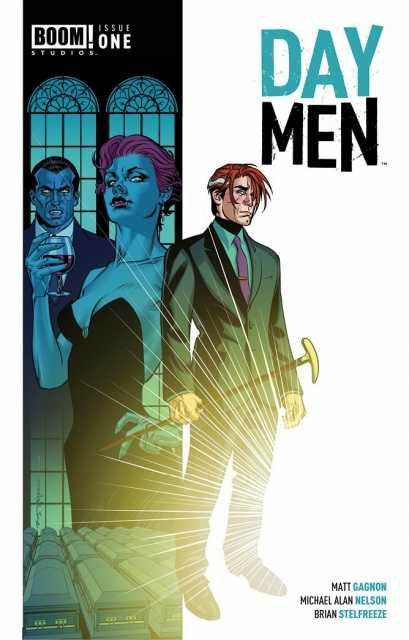"Day Men" #1 by Matt Gagnon, Michael Alan Nelson and Brian Stelfreeze adds some fangs to the crime genre, where instead of five families of Mafia, there are 50 families of vampires and their territory and associates.
Despite its body count, the prevalence of bloody hand-to-hand combat over gunfire and of course, the presence of vampires, "Day Men" isn't a horror comic. Its true genre is organized crime with an undead twist. David Reid is a Day Man, a human who works for vampires and facilitates their affairs in the sunlit hours, and "Day Men" #1 is a regular day in that life that goes from bad to worse, but predictably so.
"Day Men" #1 is a great example of a book in which execution is superior to concept. Very often, it's the other way round. Gagnon and Nelson's plot is a blending of familiar elements in the usual way of vampire or organized crime lore. At first, the set-up doesn't seem to justify the inclusion of vampires at all. The writers seem to be saving the bloodsucking violence for later issues, focusing only on the combat and controlled vendettas of intra-mob warfare.
The characters all fit into standard templates. There's the earnest rookie (David), the capable woman (Casey), the strong leader (Titus), the veteran soldier and opposite number (Jacob the Burner), the seductress (Kellen), the ne'er-do-well (Nybor). David, the point-of-view narrator, is bland but accessible. It's a fun mix, but so far there's little depth of characterization because "Day Men" #1 is more concerned with world-building and action.
Despite how the mechanics of the world are derivative, "Day Men" #1 is very well-constructed. The pacing is finely controlled throughout, and there are rich details that flesh out the backbone of the bones of the story. This is where the vampiric element starts to justify itself. Gagnon and Nelson's worldbuilding is freshest in their creation of new vocabulary. The term "Sundog" is a natural-sounding word to refer to a job. Conversational details are similarly well-thought out, like how Jacob the Burner and David repeat the catchphrase "Lux in Tenebris" (Latin for "Light in Darkness") when they take their leave of each other.
However, for transitions and backstory, Gagnon and Nelson's script is text-box heavy. There is a mix of show and tell, which is forgivable for a debut issue, but "Day Men" #1 would be stronger if Gagnon and Nelson allowed Stelfreeze's art to do more of the storytelling.
Stelfreeze makes much-anticipated return to drawing interior art for a monthly ongoing title in this debut issue. His art has graceful heavy lines with elegant background details like Art Nouveau brass latticework inside a mansion. His high-contrast shadows and outlines suit the story's themes of power and wealth and day vs. night, too.
The series is more about order than chaos, and Stelfreeze minimizes the gore, with the bloodiest action (a heart being yanked out a chest) deliberately set into the background. A long hand-to-hand combat scene has some beautifully choreographed decompressed action. Here, Gagnon and Nelson also emphasize the connection between sport and combat, taking a cue from American football to explain how a human can possibly be a match for a stronger and faster opponent.
"Day Men" #1 is a solid beginning in how it sets up the conflict and sketches out the cast and texture of its world, but to further make its mark in the crime genre or vampire fiction, the Gagnon and Nelson's characterization will need to eventually catch up with the strong pacing, lingo and Stelfreeze's visuals.

